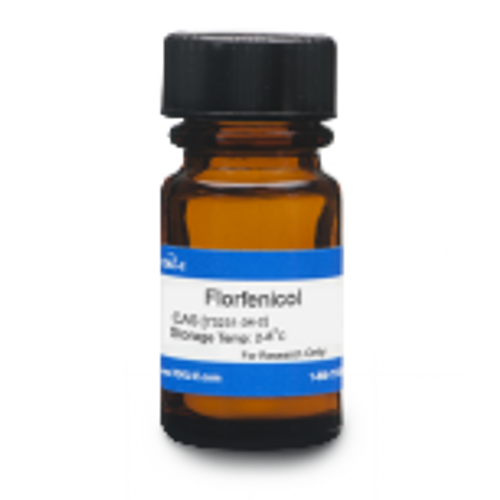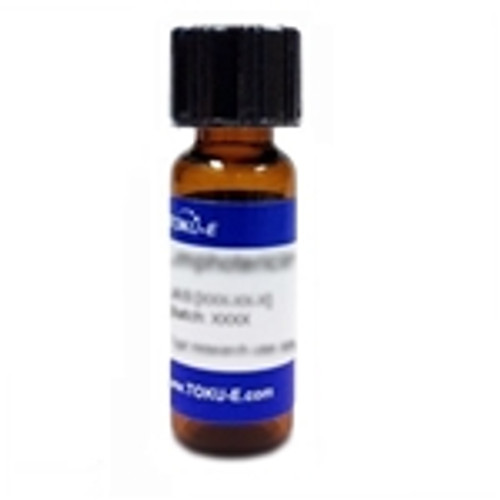Florfenicol is a fluorinated synthetic analog of Thiamphenicol, belonging to the amphenicol class which also contains Choramphenicol. It is metabolized to Florfenicol Amine. The compound is a highly potent inhibitor of bacterial protein synthesis and has bacteriostatic activity. The product is used in animal research applications against bacterial infections, and to promote animal growth in aquaculture. Florfenicol is soluble in DMSO and DMF, but sparingly soluble in aqueous buffers.
We also offer:
- Florfenicol Amine (F027)
| Mechanism of Action | After entering a bacterial cell, Florfenicol binds to the 50S ribosomal subunit preventing peptide bond formation. Resistance to Florphenicol may be due to decreased cell permeability or a mutation in the 50S ribosomal subunit. |
| Spectrum | Florfenicol is a broad-spectrum antibiotic targeting a wide variety of Gram-positive and Gram-negative bacteria, especially those causing bovine respiratory infections such as bovine respiratory disease (Mannheimia haemolytica, Pasteurella multocida, and Histophilus somni). It can also be used for the bacteria causing enteric septicemia in catfish. |
| Microbiology Applications | Florfenicol is commonly used in clinical in vitro microbiological antimicrobial susceptibility tests (panels, discs, and MIC strips) against Gram-positive and Gram-negative microbial isolates. Medical microbiologists use AST results to recommend antibiotic treatment options. Representative MIC values include:
The first Florfenicol resistance gene (pp-flo) was found in a fish pathogen. Plasmid-mediated Florfenicol resistance is encoded by the floR gene in E. coli (Cloeckaert et al, 2000).
|
| Eukaryotic Cell Culture Applications | Florfenicol was found to show immunosuppressive activity on mouse splenocytes that were harvested to assess lymphocyte proliferation of CD3+T and CD19+B lymphocytes. The compound suppressed splenocyte proliferation, demonstrating that it could suppress humoral and cellular immune responses in mice (Shuang et al, 2011). |
| Cancer Applications | Florfenicol is a substrate of Breast Cancer Resistance Protein (BCRP) as indicated by the bidirectional transport assay in Madin-Darby canine kidney (MDCK) and MDCK-chABcg2 cells. BCRP is one of the most important ATP-binding cassette superfamily transporters. Although it was discovered in cancer, it is also expressed in other normal animal tissues such as the apical membrane of enterocytes, hepatocytes and renal tubular cells where they can limit GI absorption (Liu et al, 2018). |
| Molecular Formula | C12H14Cl2FNO4S |
| Solubility | Soluble in DMSO and DMF. Sparingly soluble in aqueous buffers. |
| Impurity Profile | Residue on Ignition: ≤0.1% Heavy Metals: ≤20ppm Total Impurities: ≤2.0% Fluorine: ≤4.8% Chloride: ≤0.02% |
| References |
Cloeckaert A et al (2000) Plasmid-mediated Florfenicol resistance encoded by the floR gene in Escherichia coli isolated from cattle. Antimicrob. Agents. Chemother. 44(10):2858-2860 Liu Y et al (2018) Relevance of breast cancer resistance protein to pharmacokinetics of Florfenicol in chickens: A perspective from in vivo and in vitro studies. Int. J. Mol. Sci. 19(10):3165 PMID 30326566 Schwarz S, Kehrenberg C, Doublet B, and Cloeckaert A (2004) Molecular basis of bacterial resistance to chloramphenicol and Florfenicol. FEMS Microbiol Rev. 28(5):519-542 PMID 15539072 Shuang G et al (2011) Immunosuppressive activity of Florfenicol on the immune responses in mice. Immunol. Invest. 40(4):356-366. |
| MIC | Actinobacillus pleuropneumoniae| 0.1 - 1.56 || Aeromonas salmonicida subsp. salmonicida| 0.25 - 4 || Bordetella bronchiseptica| 1 - 32|| Escherichia coli| 0.5 - 128 || Haemophilus parasuis| 0.25 - 8 || Lactobacillus spp.| 8 - 16|| Mannheimia haemolytica| 0.12 - 32 || Mycoplasma hyopneumoniae| 0.12 - 1 || Mycoplasma hyosynoviae| 0.25 - 4 || Pasteurella multocida| 0.06 - 4 || Rhodococcus equi| 2 - >32 || Streptococcus pneumonia| 1.6 - 12 || Streptococcus suis| 0.25 - 2 || |




